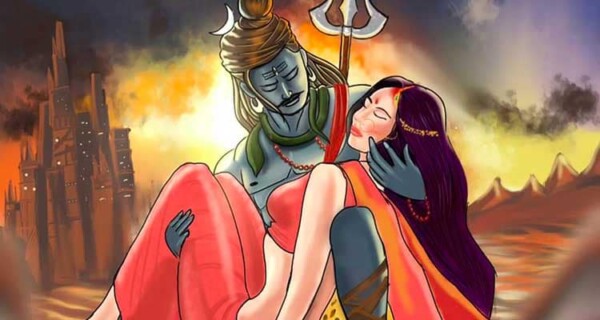They say that people in love are two souls merged into one, each complementing the other through understanding, nurture, and care. But what happens when that merged entity is ripped apart? What action does each take and what consequences do these actions have for the surroundings? Rage has a consequence that’s hard to handle.
The human psyche is no stranger to rage. If a loved one is hurt, it often seeks the path of revenge; or rather, it is tempted to seek perceived justice. Many often control their building rage, but there are some who give in.
Unintentionally, these actions cause unforeseen consequences for the outside world, even those who profess to love them. The love that they knew burned like a calm fire is not the same any more. It is now a wildfire.
But perhaps they should take a lesson from this tale – one of our very own myths, the tale of Sati.
The Rage that Shiva felt after he lost Sati
Table of Contents
Related reading: Godfire: Lessons learnt from the love of Shiva and Sati
Let me recount this tale to show you what happens when rage gets out of hand when that feeling of lost love impairs all your senses.
The god Brahma had a son named Daksha who ruled over a huge kingdom. He had many daughters, including the beautiful Sati, also known as Dakshayani. Usually, she obeyed her father, who she doted on. Likewise, Daksha too doted on her and wished for her a suitable husband.
One day, Sati went on a journey with a few of her handmaidens and entered a forest in the far north of her kingdom. There she saw an ascetic, dressed scantily in yellow and green, his hair tied up in a mound, eyes closed as if in meditation, on a small rectangular table. In front of him sat on the ground many people, dressed as scantily as the ascetic. Looking at the ascetic, she felt a strange divine aura. He was none other than Shiva himself, one of the Three Primordial Gods of the Hindu mythoverse, and the disciples around him were the Ganas, whose head was Nandi, the bull god.
Sati defied her father and married Shiva
Her heart fluttered at the sight of him and she fell immediately in love. But Lord Shiva, at that time, was a Vairagya (a Sanskrit term used in Hindu philosophy, roughly translating as detachment). To get Shiva off the path of renunciation, to consider marrying her, she did great penance.

Lord Shiva knew who she was: the embodiment of Shakti herself. But for eons he had grown so accustomed to the path of dispassion that he found it hard to partake in the pleasures of the material world. But he finally gave in.
When Sati professed her love for Shiva to Daksha, her father forbade her from meeting the Lord of Death. Daksha did not see in the ascetic God a potential bridegroom for his beloved daughter. But Sati defied him and moved to the forests after marrying Shiva.
Daksha organised a huge yagya and deliberately did not invite Shiva and Sati. Despite having warned by her husband not to go to a function where they were not invited, Sati went to the ceremony alone. Her father insulted her in front of all his guests, among whom were the Lords Brahma and Vishnu themselves. Unable to bear the snubs, Sati immolated herself in the sacrificial fire.

When Shiva felt his beloved being ripped apart by death, he invoked in his wrath Veerabhadra and Bhadrakali, who led the Ganas to a battle with Daksha. In the skirmish, Daksha was decapitated and the yagna shaala was destroyed.
Shiva, himself, in a rage, travelled throughout the world, his anger scorching the earth. Shiva started his famous tandava dance, which disintegrated Sati’s dead body into 51 pieces, each of which fell on different places. These sites are today known as Shakti Peethas.
It was only when Lord Vishnu interfered and convinced Shiva to calm down that the near-apocalypse stopped and Shiva was able to see the destruction he had wrought. He forgave Daksha and replaced his head with a ram’s head and gave back the king his life. The yagya was allowed to finish.
This Indian mythological story says how rage can be detrimental to others
The tale speaks of how rage can be detrimental to others.
Even at the loss of our dearly loved, we must learn to control ourselves. Broken relationships make us fall to the lure of the vices. And these vices do not bode well for anybody, least of all, to the person giving in.
Rather, we should nurture the love we had for the departed and give it a corner in our hearts for as long as we breathe.
Osho on love as a disease and meditation as medicine
Your contribution does not constitute a charitable donation. It will allow Bonobology to continue bringing you new and up-to-date information in our pursuit of helping anyone in the world to learn how to do anything.
Ask Our Expert
You must be Logged in to ask a question.



Featured
7 Signs Someone Is Constantly Thinking About You – It’s More Than Just Coincidence
Seeing 222 When Thinking Of Someone – Meanings And What To Do
Your Guide On Numerology Compatibility – What’s Your Life Path Number And Who Are You Most Compatible With?
Twin Flame Reunion – Clear Signs And Stages
Psychic Expert Shares 21 Spiritual Signs Your Ex Misses You And Wants You Back
What Is The Spiritual Meaning Of Being Pregnant In A Dream? 7 Possible Explanations
17 Powerful Signs From The Universe Your Ex Is Coming Back
What Is Agape Love And Its Role In Modern Relationships
Sexual Ties: Meaning, Signs, And Tips To Break Away
21 Miraculous Prayers For Marriage Restoration
Psychic Expert Shares 11 Spiritual Signs He Will Come Back
List Of Angel Numbers For Love And Relationship
10 Signs You Are In A Spiritual Relationship With Someone
11 Beautiful Ways God Leads You To Your Spouse
What Does Yin And Yang Mean And How To Find The Balance
Everyday Yin And Yang Examples In Relationships
8 Types Of Soulmates And Deep Soul Connection Signs
Cosmic Connection — You Don’t Meet These 9 People By Accident
21 Beautiful Prayers For Your Husband For Everlasting Love
In Mahabharata Vidura Was Always Right But He Never Got His Due